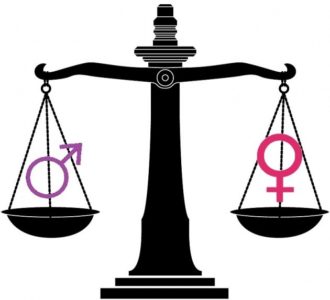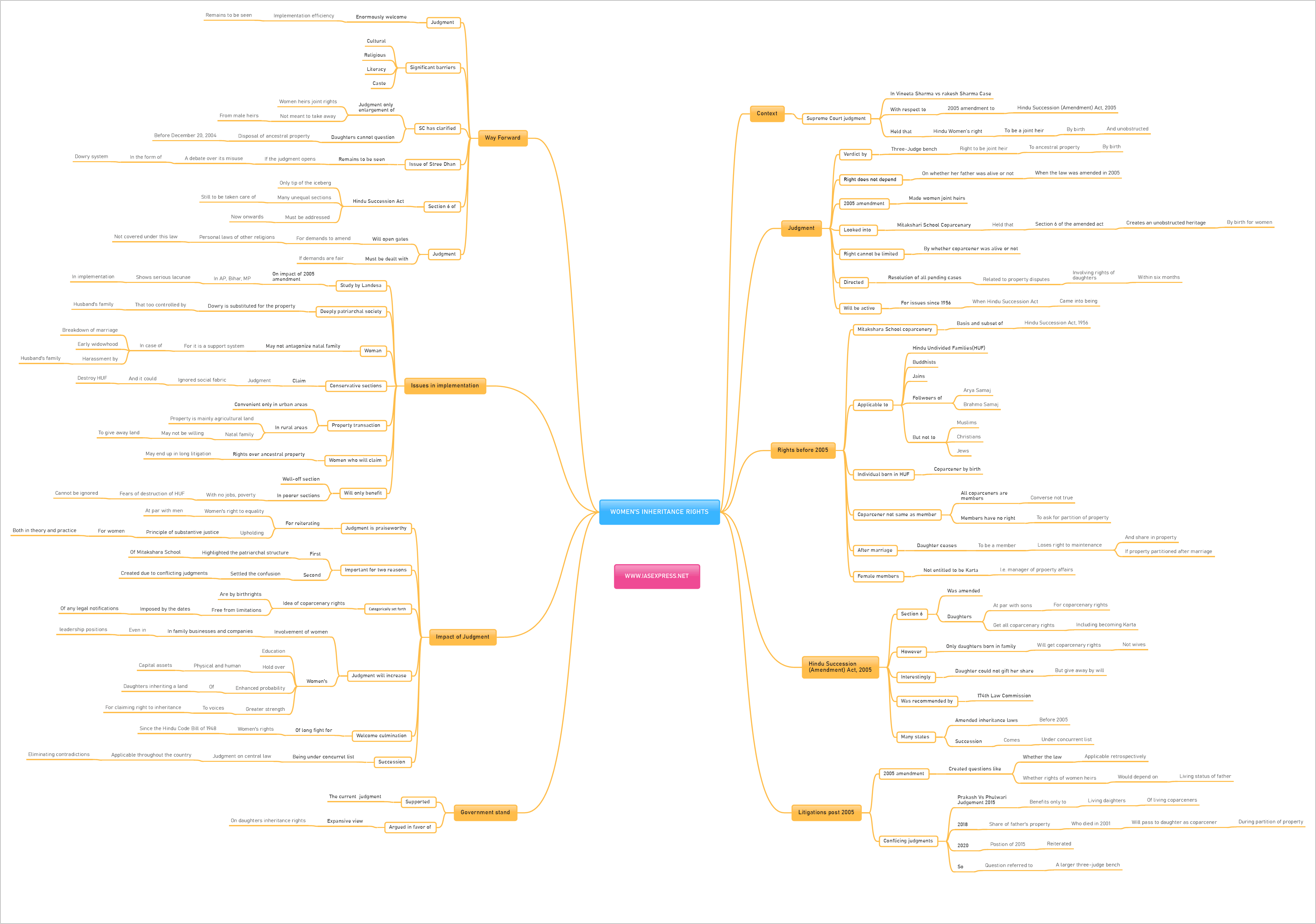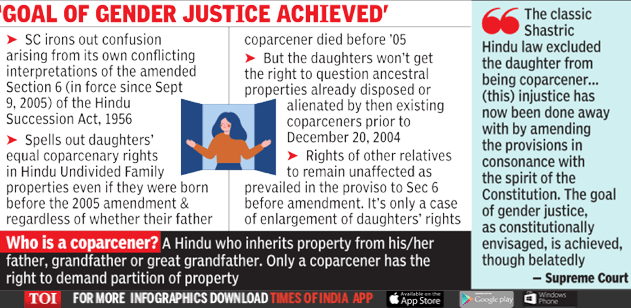SC Verdict on Women’s Inheritance Rights: Analysis

In a judgment that would remove ambiguity in Hindu women’s inheritance rights after the amendment to the Hindu Succession (Amendment) Act, 2005, the Supreme Court in its Vineeta Sharma Vs Rakesh Sharma case held that a Hindu Women’s right to be a joint heir to the ancestral property is by birth. It comes in the backdrop of various judgments providing contradictory views on the 2005 amendment and clears the confusion.
What is the SC Judgement in Vineeta Sharma Vs Rakesh Sharma case?
- The Supreme Court in its three-Judge bench ruling held that a Hindu woman’s right to be a joint heir to the ancestral property is by birth.
- It said that a Hindu woman’s right does not depend on whether her father was alive or not when the law was amended in 2005. The Hindu Succession (Amendment) Act, 2005 made Hindu women coparceners or joint-heirs, same as male heirs.
- The court looked into the rights under the Mitakshari Coparcenary. The Court held that since the section 6 of the amended act creates an unobstructed heritage or a right created by birth for the daughter of the coparcener, the right cannot be limited by whether the coparcener is alive or dead when the right was operationalized.
- The SC also directed that as far as possible, all pending cases related to property disputes that involved the rights of a daughter to be resolved within six months and noted that daughters cannot be deprived of their right to equality.
- The act will now be applied retrospectively from 1956 when the act came into being.
What were the property rights of a daughter before 2005?
- The Mitakshara School of Hindu law became the basis and subset of the Hindu Succession Act, 1956.
- As per the act, an individual who is born in a Hindu Undivided Family (HUF) becomes a coparcener by birth.
- The law applied also to Buddhist, Sikhs, Jain, and followers of Arya Samaj, Brahmo Samaj are also considered Hindus but not to who is not a Muslim, Christian, Parsi or Jew by religion. This provision is also valid for further amendments.
- A coparcener is not the same as a member of HUF. All coparceners are considered members but all members may not be considered as coparceners. A wife or husband of the coparcener is not a coparcener in that family though being a member. The benefit of being a coparcener is that only coparceners can ask for the partition of the property.
- The daughter, after marriage, would cease to be a HUF member of her father and will not be entitled to the right of maintenance and a share in the property of the HUF, if the property were partitioned after her marriage.
- The female members were not entitled to become a Karta of the HUF as only a coparcener was entitled to become the Karta of the HUF.
What is the Hindu Succession (Amendment) Act, 2005?
- Section 6 of the Hindu Succession Act, 1956 which deals with coparcener’s right in the HUF property was amended in 2005.
- With this amendment, daughters have been at par with sons, as far as coparcenary rights in HUF are considered.
- The daughters get all the rights of the coparcenary. This also includes the right to ask for partition of the property and to become a Karta of the HUF.
- However, only the daughters who are born in the family will get the coparcenary rights. Other female members who come into the family by virtue of marriage, were still treated as members only. Thus, they were not entitled to ask for the partition but were entitled to maintenance and shares as and when partition takes place.
- According to amendment, a daughter would cease to be a member of HUF but continued to be a coparcener. Thus, she was entitled to ask for partition of the HUF property, as well as to become a Karta of the family if she was the eldest coparcener of her father’s HUF.
- Even in the case of a married daughter who has died, her children would be entitled to the shares that she would have received if she were alive on the day of partition.
- Interestingly, the daughter could not gift her share in the HUF property while she was alive but was fully capable of giving away her share in the HUF property by way of a will.
- The 174th Law Commission report had recommended this reform in Hindu Succession Law. Since succession is under the concurrent list, even before the amendment in 2005, many states such as Andhra Pradesh, Karnataka, Maharashtra, and Tamil Nadu made this change in the law. Kerala had abolished the Hindu Joint Family system in 1975.
What were consequent litigations after the law was amended?
- When the law was amended, there were questions as to whether the law is applicable retrospectively. It was also asked if the rights of women depended on the living status of the father through whom they would inherit.
- The conflicting judgments of different SC benches and High Courts had created confusion with respect to the status of law.
- In Prakash Vs Phulwari Judgement (2015), a tow bench judgment held that the benefits of 2005 amendments could be granted only to living daughters of living coparceners.
- In 2018, a two-bench judgment decided that the share of a father’s property who died in 2001 will also pass to his daughters as coparceners during the partition of property.
- Again, in April 2020, the 2015 position was reiterated. So, these conflicting judgments by the same strength benches led to a reference to a three-judge bench in the current case.
What is the government stand on the judgment?
- The Solicitor general argued for the expansive reading of the law to allow equal rights for women.
- He submitted that the Mitakshari coparcenary law not only contributed to discrimination on the ground of gender but was oppressive and negated the fundamental right of equality guaranteed by the Constitution of India.
What is the impact of this judgment?
- The judgment is praiseworthy simply for reiterating the idea that women are born as equals and the patriarchal system and its unequal structures are no longer valid.
- The judgment is important for two reasons. First, it highlighted the patriarchal structure of Mitakshara School, and second, it settled the confusion created due to conflicting judgments as discussed above.
- The SC categorically set forth the idea of coparcenary rights are by birthrights and free from limitations imposed by the dates of any legal notifications.
- By the judgments, the SC has upheld the principle of substantive justice for women both in theory and practice.
- Not only property rights, experts believe that this judgment can increase the involvement of women in family businesses and companie Also, it could propel them to leadership positions.
- There are empirical studies that suggest that the 2005 amendment has changed the lives of women for better.
- Studies have proven that the reform has positively impacted women’s education, labor force participation, and their daughter’s education.
- The amendment has led to greater access to women-owned physical and human capital assets, and has enhanced the probability of daughters inheriting land.
- In patriarchal families, women are afraid to raise their voices for equality. With this judgment, all women have equal rights to ancestral property.
- It is a welcome culmination of a fight for equality in HUFs since the days of the Hindu Code bill (1948) which could not materialize due to protests by conservative sections of the society.
- Since, succession is under concurrent list, as per article 254(1) of the constitution, state amendments if inconsistent with the central amendments, would be inoperative and central amendments would prevail.
- This is significant since though some states have been progressive even before the 2005 amendments, there was only a partial transfer of rights. For example, in some states, rights in property were only given to unmarried daughters when these amendments came into force.
What are the issues in implementation?
- A study by Landesa in three states- Andhra Pradesh, Bihar, MP- for examining the impact of the 2005 amendment has shown that there exist serious lacunae in the formal system and prevailing social practices that obstruct the effective implementation.
- In a deeply patriarchal structure, dowry is substituted for the property transfer. Even in the case of dowry, women have no agency over it and the male members of the husband’s family control it.
- It is not easy for a woman to antagonize their natal family and approach courts, seeking an assertion of their property rights as they remain a support system for the woman in eventualities like breakdown of marriage or harassment by husband’s family.
- A large section of the population is already claiming that this decision will bring family relations under stress. They contend that the judgment has not taken into account the social fabric of a HUF and it will destroy HU
- Property transactions may be convenient for urban settings but not for rural areas as in rural areas main property type is agricultural land.
- Women who will claim rights may end up in long litigations. With entrenched patriarchy, male heirs of the property may not easily share documents regarding property with women heirs.
- On occasions, law and courts may turn progressive, but the society remains far from progressiveness. The challenges for largely illiterate women who are denied basic dignities in trying to demand their rights are huge.
- This judgment is likely to benefit only well-off propertied class. Increasing poverty, retrenchments and job losses faced by Indian society in recent times, the property available for succession is considerably reduced.
Way forward
- Though the judgment is enormously welcome, it remains to be seen if it results in any substantive change on the ground. Significant cultural, religious, educational barriers remain massive hurdles in the path to equality.
- Some of the fears have been addressed by the SC It has said that the judgment will not affect the rights of other relatives. It said that the judgment only enlarges the rights of the daughters.
- For example, Daughters cannot question the disposal or alienation of ancestral properties by the existing coparceners before December 20, 2004.
- The issue of Stree Dhan, as explained in section 14(1) of the Hindu Succession Act, is upturned by this judgment. The Stree Dhan concept, over the period, had created an issue of dowry. As the section says that women can acquire property as a full owner and it can be carried over or retained post marriage. The current judgment opens Stree Dhan for wider debate and possibly radical change in the dowry system.
- Section 6 of the Hindu Succession Act is the tip of the iceberg. There are many gender discriminatory provisions in the law. First, the Hindu Mitakshara law of coparcenary has traditionally given coparcenary rights as a birthright to all male members of the Hindu joint family within three generations after the last holder of the property. In contrast, the 2005 amendment has only carved out coparcenary rights by birth for daughters, not all women in the Hindu joint family.
- It remains to be seen whether this fight for equality will be extended in other cases of inequalities such as above.
- It also remains to be seen if the reforms in Hindu Succession laws will open the gates for other succession laws as that of Islamic and Christian succession laws. For example, the Islamic laws though are relatively progressive by giving property rights to women heirs, the property distribution is discriminatory.
Conclusion
The Supreme Court must be applauded for its continuous zeal in reforming laws that are at fault when it comes to gender equality. The judgment is another such act. It remains to be seen how the substantive portions will be implemented on the ground without creating any ruckus in a deeply patriarchal society of India and also without further legal challenges to the judgment.
Practice Question for Mains
Critically analyze the Supreme Court Judgment in Vineeta Sharma Case for its reform in women’s inheritance rights. (250 words)
https://thewire.in/law/hindu-succession-act-women-supreme-court
https://housing.com/news/these-are-the-property-rights-of-a-daughter-in-a-hindu-family/
https://www.livemint.com/money/personal-finance/who-is-a-coparcener-11589905200213.html
https://www.mondaq.com/india/family-law/518126/basic-tenets-of-a-hindu-undivided-family
If you like this post, please share your feedback in the comments section below so that we will upload more posts like this.




please provide pdf format for easy download. I paid and joined in your course work